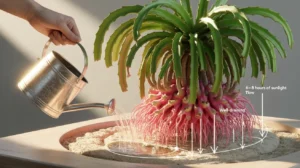Dragon fruit care is simple, fun, and something anyone can learn—even if you’ve never planted anything before. Dragon fruit is a bright, colorful fruit that grows on a cactus. It looks strange at first—spiky on the outside, soft and sweet inside—but it’s easy to grow and really good for your health.
You don’t need a big garden or special tools to grow it. A large pot, some sunshine, and the right kind of soil are enough to get started. This cactus doesn’t like too much water and loves warm places. Giving it a little support to climb helps it grow fast and produce amazing fruit with proper dragon fruit care.
Many people grow dragon fruit at home because it’s fun to watch, easy to take care of, and gives you fruit that’s both tasty and healthy. In this guide, you’ll learn how to plant it, help it grow, protect it from problems, and pick it when it’s ready. By the end, you’ll know exactly how to enjoy growing your own dragon fruit—from start to finish—with easy and smart dragon fruit care tips.
Table of Contents
Toggle1. Meet the Dragon Fruit: Nature’s Spiky Superfruit
Dragon fruit, also called pitaya, is a special fruit that grows on a type of cactus plant. Unlike regular cacti that stay small and round, this cactus grows like a climbing vine. It can wrap around poles, fences, or walls and needs support to grow well.
The fruit is easy to recognize because of its bright pink or yellow skin with green spikes. Inside, it has white or red flesh filled with tiny black seeds. It looks strange but tastes sweet and refreshing. This makes dragon fruit a favorite for many people who want something healthy and tasty.
One amazing fact about the dragon fruit plant is that its flowers bloom only at night. These big, white flowers smell sweet and close early in the morning. This night bloom helps attract special pollinators, like bats or moths, which help the plant make fruit.
There are different types of dragon fruit — some have red skin with red flesh, and others have yellow skin with white flesh. All types are full of vitamins, fiber, and antioxidants that are great for health.
If you want a plant that is easy to care for, looks beautiful, and gives delicious fruit, the dragon fruit plant is a perfect choice for your garden.
Starting Right: Choosing the Perfect Variety and Setup
Starting your dragon fruit growing adventure is exciting, but choosing the right plant is very important. There are different dragon fruit varieties, and each one has its own special needs. For example, if you want fruit quickly, the red dragon fruit is a good choice because it grows fast and produces fruit earlier. But if you like very sweet fruit, the yellow dragon fruit is great, even though it takes a little longer to grow.
Where you live also matters. Dragon fruit plants like warm weather and lots of sunlight. If you live somewhere cold, it’s best to grow your dragon fruit plant in a pot. This way, you can bring it inside when it gets too cold outside.
Before planting, give your cactus a strong place to climb like a fence or a trellis. The dragon fruit cactus grows like a vine, so it needs support to grow tall and healthy.
By picking the right type and giving it the best home, you start your dragon fruit care journey the right way — making it easier to grow tasty fruit at home.
3. Soil, Light, and Water: The Golden Trio of Growth
Think of your dragon fruit plant like a friend who loves playing outside but hates standing in puddles. To keep it happy and healthy, you need to give it the right soil, sunlight, and water. Proper dragon fruit care means balancing these just right.
First, the soil. Dragon fruit needs well-draining soil. This means the soil should let water pass through quickly so the roots don’t stay wet too long. If the roots sit in water, the plant can get sick and stop growing. A mix of sandy and loose soil works best to keep the roots dry and healthy.
Next, sunlight. Your dragon fruit plant loves sunshine and needs at least 6 to 8 hours of bright light every day. Without enough sun, the plant grows slowly and might not give you any fruit. Good dragon fruit care always includes proper light.
Finally, watering. Dragon fruit plants don’t like too much water. Imagine giving your plant a drink when it’s thirsty but not making it swim! Water it deeply about once a week during warm weather but wait until the soil feels dry before watering again.
Giving your dragon fruit the right soil, lots of sunlight, and just enough water is key to successful dragon fruit care — helping it grow strong and produce tasty fruit for you to enjoy.

4. Training Your Cactus: Building a Home It Can Climb
The dragon fruit plant is different from most cactuses. Instead of standing straight up, it likes to grow like a climbing vine. So, it needs something strong to hold on to as it grows.
Think of your dragon fruit like a climber who needs a ladder to reach higher. This ladder is called a trellis or a plant support. You can make one easily using wooden sticks, bamboo, or even an old fence. Make sure it is strong because the plant can get heavy when it grows bigger.
When your dragon fruit starts to grow, tie the branches gently to the support using soft string or cloth. Don’t tie it too tight because the plant needs space to grow without being hurt. Keep helping your plant climb by adding more ties as it gets taller.
Training your plant to climb is an important part of dragon fruit care. Proper dragon fruit care helps your plant get more sunlight, stay healthier, and produce more delicious fruit for you to enjoy at home.
5. Feeding the Fire: When and How to Fertilize
Your dragon fruit plant needs the right food to grow big and healthy — just like an athlete needs good meals to train well. This food is called fertilizer. Giving your plant the right fertilizer at the right time is a key part of Dragon Fruit Care, helping it grow strong stems, bright flowers, and tasty fruit.
When your dragon fruit is young and growing, it needs fertilizer with more nitrogen. Nitrogen helps the plant make green leaves and strong stems. You can use a balanced fertilizer like 10-10-10 or 8-8-8 that gives the plant the food it needs to grow fast.
When your plant starts to bloom and make fruit, it needs fertilizer with more phosphorus and potassium. These help flowers grow well and fruit become sweet and juicy. Fertilizers like 5-10-10 or ones made for flowering plants work best now.
Feed your dragon fruit plant every 4 to 6 weeks during warm months. Don’t give too much fertilizer because it can hurt the plant. Always follow the instructions on the fertilizer package to keep your dragon fruit cactus healthy and happy.
By feeding your plant the right way, you help it grow, bloom, and produce delicious fruit — this is the heart of good Dragon Fruit Care.
6. Pollination Secrets: From Flower to Fruit
The dragon fruit flower is very special because it only opens at night. These big white flowers bloom after dark and close early in the morning. Normally, night pollinators like moths and bats visit the flowers to carry pollen from one flower to another. This process, called pollination, helps the flower turn into a juicy dragon fruit.
If you are practicing good Dragon Fruit Care at home, sometimes there might not be enough pollinators around. So, you can help the plant by doing manual pollination. This means using a small brush or cotton swab to gently move pollen from the flower’s male part (stamen) to its female part (pistil). It’s easy to do and fun too!
By helping your dragon fruit this way, more flowers will grow into fruit. Watching the fruit grow after you pollinate is exciting and makes Dragon Fruit Care even more rewarding. Learning about pollination is a great way to ensure your dragon fruit cactus produces lots of tasty fruit.

7. When the Magic Happens: Spotting and Harvesting Ripe Fruit
Knowing when to pick dragon fruit is like spotting a yummy prize! At first, the fruit is green and smooth. As it grows, the color changes. Most dragon fruits turn bright pink, red, or yellow when they are ready to eat. Watch the color carefully. When it gets brighter and deeper, that means the fruit is almost ready. Also, look at the little leafy parts on the skin called “wings.” When these wings start to dry and curl back, it means your dragon fruit is ripe and sweet!
The skin should feel firm but not too hard, and it shouldn’t have soft or wrinkled spots. If you wait too long, the fruit might get too soft or start to rot. To pick the fruit, use a clean knife and cut it from the plant, leaving a small stem. This helps the fruit stay fresh longer.
Watching these easy signs is an important part of Dragon Fruit Care so you can enjoy sweet, juicy, and fresh dragon fruit from your garden every time!
8. Off-Season and Long-Term Plant Care
Taking care of your dragon fruit plant doesn’t stop when the fruiting season ends. To keep your plant healthy all year, you need to help it rest and get ready for next year.
When the fruit is gone, it’s time to prune the plant. This means cutting off dead or too-long branches. It helps the plant grow better and stay strong.
In cold weather, dragon fruit plants can get damaged. They don’t like frost. If you live in a cold area, cover the plant with cloth or move it inside if it’s in a pot. Keeping it warm helps it survive winter.
During the winter months, don’t water too much. The soil should stay a little bit moist, not wet. Also, don’t use fertilizer in winter — wait until spring when the plant starts growing again.
Every year, check the trellis or post the plant is climbing. Make sure it’s still strong and steady.
With a little care during the off-season, your dragon fruit will stay happy and grow fruit again next year. Dragon fruit care is easy when you understand its needs, even when it’s resting!
9. Common Problems and Natural Solutions
Dragon fruit plants are like friendly pets — they tell you when something is wrong, but not with words. You just have to look closely.
If the stems feel soft or squishy, your plant may be getting too much water. That’s bad for dragon fruit. They like soil that drains fast. So, don’t let water sit in the pot. Let the soil dry before you water again.
If the ends of the plant turn yellow or brown, it could mean too much sun or not enough water. Try giving your plant a little shade during hot afternoons and water early in the day.
If you see tiny bugs or white fuzz, these are often aphids or mealybugs. Don’t worry! Mix a bit of neem oil with water and spray it on. It’s a natural bug remover.
Got ants or mold? Just sprinkle cinnamon powder around the plant. It’s safe and works like magic.
By learning these signs and using simple, natural fixes, your dragon fruit will stay healthy, strong, and grow yummy fruit!
10. The Joy of Growing Dragon Fruit at Home
Growing dragon fruit at home is like watching a fun science project turn into a real, yummy fruit. It’s not just about planting — it’s about learning, caring, and enjoying the journey from start to fruit!
Now you know how to pick the right dragon fruit plant, give it the best soil, sunlight, and water, and help it climb and grow strong. You’ve learned how to pollinate flowers by hand, how to spot when the fruit is ready, and even how to protect your plant from bugs — all using simple, natural methods.
This plant is a great choice for beginners, kids, and anyone who wants to try easy fruits to grow at home. It teaches patience, care, and gives you a sweet reward!
So go ahead — start your dragon fruit growing journey today. It’s fun, colorful, and totally worth it. And the best part? You grew it all by yourself!
Frequently Asked Questions (FAQs)
How long does it take for dragon fruit to bear fruit?
Dragon fruit plants usually start producing fruit within 6 to 12 months if grown from a cutting. If you grow them from seeds, it may take 2 to 3 years. With the right support, sunlight, and consistent dragon fruit care, the plant can bloom and produce fruit much more quickly.
Can dragon fruit grow indoors?
Yes, dragon fruit can grow indoors if you provide plenty of light — ideally near a sunny window or under a grow light. Keep it in a large pot with well-draining soil, and make sure the room stays warm (above 60°F/16°C). With the right dragon fruit care, your indoor plant can stay healthy and may even produce fruit over time.
Why are my dragon fruit flowers falling off?
Flower drop often happens due to poor pollination, lack of sunlight, or stress from overwatering. As part of good Dragon Fruit Care, make sure your plant gets enough sun and has proper support. Hand-pollinating with a small brush can also improve fruit development and reduce flower loss.
Does dragon fruit need hand pollination?
Some dragon fruit varieties are self-pollinating, but many need help. As part of proper Dragon Fruit Care, hand pollination is a smart step — especially if you’re growing the plant in areas without natural night pollinators like moths or bats. Gently transferring pollen using a small brush or cotton swab can boost fruit production and ensure your plant produces healthy, delicious fruit.
What’s the best organic fertilizer for dragon fruit?
As part of good Dragon Fruit Care, use a balanced organic fertilizer like composted manure, worm castings, or seaweed-based liquid feed. These natural options help the plant grow strong and healthy without causing chemical buildup in the soil, keeping your dragon fruit plant thriving for the long term.



